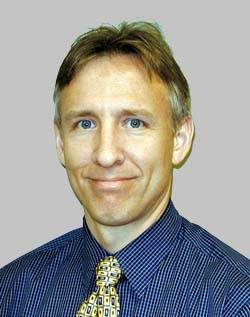
 | Chapter Chatter |
Todd Hubing, Associate Editor |
| Finally! I'm finally getting around to writing the Chapter Chatter
column for the summer issue of the Newsletter. I confess, I'm two weeks late,
but this time I've got a good excuse. I spent the last 3 weeks in Japan visiting
Okayama University. They have a top-notch EMC Laboratory and I was there to learn
more about the research they are doing in printed circuit board and VLSI EMC.
While I was in Japan, I also had an opportunity to visit several EMC Laboratories
in the Tokyo area where excellent research is being conducted. I was particularly
impressed with work being done with high-resolution near-magnetic-field scanning,
power-bus noise simulation and measurement of VLSI devices, and ultra-high-speed
data buses on multi-layer printed circuit boards. Prof. Ryuji Koga and Prof. Osami Wada of Okayama University were excellent hosts. They made sure my trip was both enjoyable and productive. My Japanese is not very good, but I did manage to pick up three Japanese words: Kampai – "Let's drink this beer." Arigato – "Thank you for the beer." Kudasai – "More beer, please."
It's amazing how well one can get around in Japan with a vocabulary of three words. On occasions when I was exploring the city of Okayama on my own, I found that I was able to communicate with the people very effectively using exaggerated gestures and pantomime. The next time you see me at a conference, I'll be happy to show you a very effective way to ask for the location of the nearest restroom without using words. The trip to Japan was enjoyable, but we also worked pretty hard, so I didn't have time to write my column while I was there. When I came back, I had three weeks worth of miscellaneous tasks to take care of. The most important task, of course, was to write the Chapter Chatter column for the summer issue of the EMC Society Newsletter. So obviously this was the first thing I did, right? Well, not exactly. Let me explain the first rule in the Hubing School of Time Management: Do the least important things first. Why? Because, the most important things will always get done somehow. For example, suppose your list of things-to-do has three items:
Clearly these items do not have equal priority. The appendix is a life or death matter and therefore this task should be done last. After all, if you have the appendix taken care of first, you might not get around to the other tasks. However, even if you do the other tasks first, it is unlikely that you will decide you don't have time for the appendix. See what I mean? The Hubing School of Time Management dictates that the office be organized first. Otherwise this will probably never happen. Next, the Chapter Chatter column can be written. After all, this item has a deadline. Finally, the appendix can be removed. No matter how much time was spent on the first two tasks, the third one will surely be completed. This system is contrary to anything you are likely to learn in anyone else's time management course, but it works for me. I generally manage to meet deadlines and yet I don't neglect lower priority items. If you are reading these words in the summer issue of the EMC Society Newsletter, then my column was received prior to the absolute-final-now-or-never deadline. Plus, I had a great time in Japan and my office looks really good. Now, if you will excuse me, I'm going to defragment my hard drive and then I'm off to the emergency room... |
Kurt Lamedschwandner, Chair of the Austria Chapter of the IEEE EMC Society reports that their meeting on June 29th featured a very interesting lecture by Prof. Hadrian, Technical University Vienna. The topic of his presentation was "Shielding of Rooms against Low-Frequency Electromagnetic Fields". After the lecture, the chapter held a nice social event in Vienna. This autumn, a meeting is planned in Graz, the second largest city in Austria.
 |
The opening ceremony of CEEM 2000 Shanghai attracted several members of the regional EMC community including (L-R) Deng Zhenyin, Ye Peida, Song Zhiyuan, Gao Yougang, Shuichi Nitta, Yang Qianli, Zhang Weihua and Lin Jintong. |
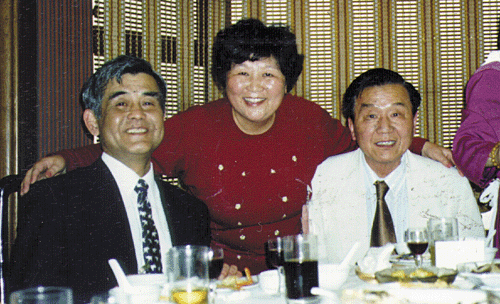 |
Prof. Shuichi Nitta, Dr. Yu Defen, and Prof. Gao
Yougang, (L-R) |
Gao Yougang, Chair of the Beijing Chapter, reports that the Second Asia-Pacific Conference on Environmental Electromagnetics – CEEM 2000 was held in Shanghai, China in May. It was co-sponsored by the China Institute of Communications, Beijing University of Posts and Telecommunications, The Institute of Electrical Engineers of Japan and the Institute of Electronics, Information, and Communication Engineers of Japan (IEICEJ). Both the IEEE EMC Society and the IEEE Communications Society were Technical Co-sponsors.
The Technical Program Committee received about 120 papers. 80% of these papers were accepted and published in the proceedings. The authors were from China, Japan, Korea, United States, Germany, Sweden, Switzerland, Italy, Poland, Finland, Singapore, and Thailand. More than 100 participants attended this conference. The Conference provided a forum to exchange information on the progress of research and development in electromagnetic theory, antennas, wave propagation, electromagnetic environments, earthquakes, ESD, lightning and NEMP, bioeffects, and EMC-related areas. The exhibition held along with the conference featured manufacturers from China and other countries showing products of high quality. The conference was a huge success. The Third Conference on Environmental Electromagnetics will be held in Hangzhou, China in November 2003.
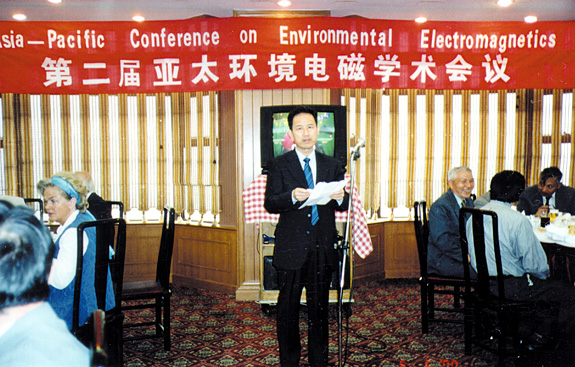 | |
Prof. Yang Qianli made a short speech during the conference banquet. | |
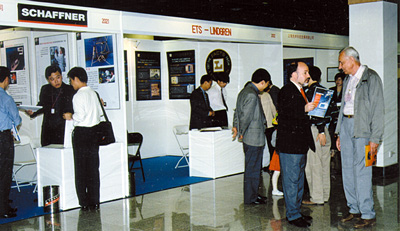 |  |
Prof.
Trzaska and Dr. Hansen visited the exhibition area | On May 22-23, EMCS Distinguished Lecturer Mark Montrose spoke to the Beijing EMC Chapter at a meeting held at the Beijing University of Posts and Telecommunications. |
Dr. Li Shufang reports that a meeting of the Beijing chapter on May 22nd and 23rd featured IEEE EMC Society Distinguished Lecturer, Mark Montrose. Mark was invited to China by Prof. Gao Yougang. He gave an 8-hour lecture on "EMI and the PCB." That covered the fundamentals of signal integrity, fundamentals of EMC, basic EMC suppression concepts, bypassing and decoupling, trace routing, layer jumping using vias, crossing the barrier, and ESD protection. After his talk, there was an enthusiastic discussion about PCB design techniques. Mark answered many questions related to PCB design and layout. Thirty-one researchers attended the lecture from many famous universities, research institutes and companies such as Tsinghua University, Beijing University of Posts and Telecommunications, the Electronics Institute of China Scientific Academy and the Dongfang Telecommunications Company. Everyone who attended was interested in the topic and satisfied with the result.
John Clarke, Chair of the Central New England Chapter, reports that Kevin P. Baldwin, of EMC Test Systems in Norwalk, CT, was the featured speaker at their April meeting. Mr. Baldwin spoke on "CASSPER, 'The Virtual Chamber' EMI Ambient Cancellation and Source Localization." The speaker provided a description and demonstration of the system. The CASSPER system effectively brings an open area test site (OATS) into the laboratory or onto the production floor, measures EMI and determines compliance at any location. CASSPER is a new PC-based instrumentation system that records and isolates EUT signals of interest without the need for anechoic chambers. The system delivers true ambient cancellation and removes the guesswork in signal identification. The product's coherence measurement feature allows you to identify and locate sources of EMI noise including multiple sources at the same frequency. Twenty-two people were on hand for Mr. Baldwin's presentation.
Denise Haley, of Agilent Technologies in Andover, MA, was the featured speaker at the May meeting. Her presentation was titled: "Overview of the European Union (EU) Radio Equipment and Telecommunications Terminal Equipment (R&TTE) Directive." Ms. Haley provided a comprehensive review and current status of the EU R&TTE Directive. Compliance to the Directive became mandatory on April 8, 2000 for all radio and telecommunications products being marketed in the EU. The speaker discussed the key elements of the Directive including scope, essential requirements, CE mark and other labeling specifications, and conformity assessment procedures. An up-to-date status of the Directive including references to recently published harmonized standards and member states' requirements were also covered, as well as a review of how one medical device manufacturer incorporated the Directive into their system.
CNEC EMCS Chapter Officers elected for 2000/2001: Chairperson and Secretary - John Clarke, Co-Chair-John Luchini, and Co-Vice Chairs - Lee Hill and Boris Shusterman.
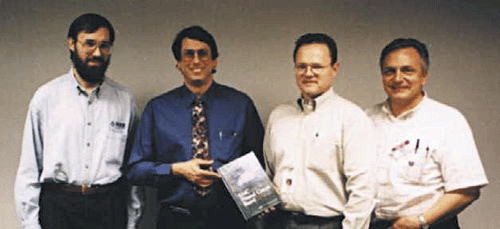 | 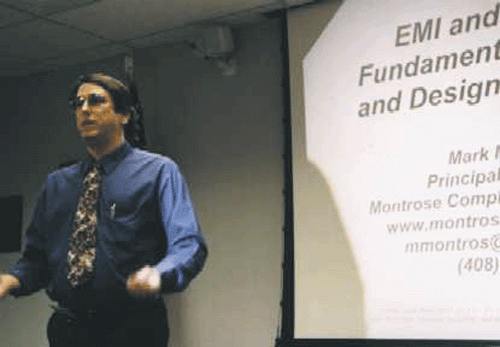 |
Mark Bushnell (Dallas EMC Chapter Chair), Mark Montrose
(Distinguished Lecturer guest | Mark
Montrose, EMCS Distinguished Lecturer, was guest |
 | 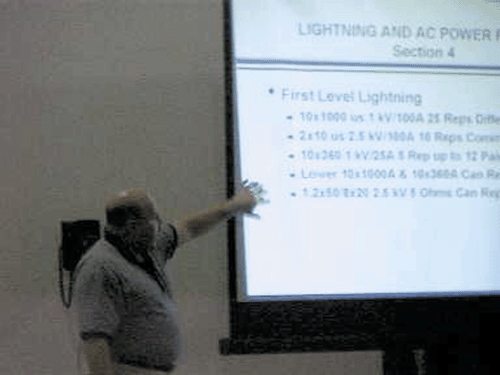 |
| David
Watkins demonstrates the new CASSPER product to the Dallas Chapter. | Jim
Press presented information about Bellcore requirements at the March Dallas Chapter Meeting. |
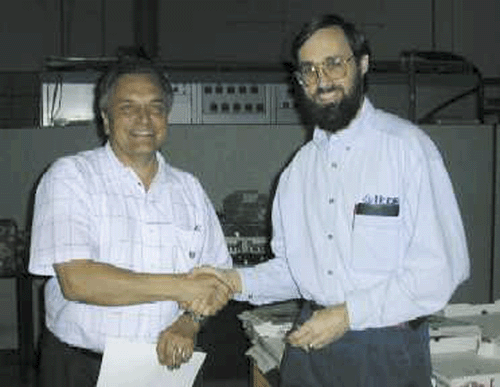 | |
| Gary Shimko (2000-2001 Dallas Chapter Chair) presents the past Chapter Chairman's lapel pin to Mark Bushnell. |
The first meeting in 2000 of the Dallas EMC Chapter was held on January 18th at Intertek Testing Services, Richardson, Texas. The guest speaker was Bill Holz, ITS National Sales Manager, who spoke on "International Telecom Testing and Approvals". There were 23 in attendance (15 IEEE members).
The February 2000 Dallas EMC Chapter meeting was held on February 15th at Abbott Labs, Irving, Texas. The guest speaker was Distinguished Lecturer Mark Montrose, speaking on ÒEMI and the PCB - Fundamental Concepts and DesignÓ. There were 38 in attendance (16 IEEE members). A copy of MarkÕs second book, ÒEMC and the Printed Circuit BoardÓ, was given as a door prize to Chris Steidle, of Abbott Labs, holder of the winning ticket. No one claimed the second door prize, a gift certificate for a Don Heirman haircut at the Rolla Barber Shop.
The March 2000 Dallas EMC Chapter meeting was held on March 21st at National Technical Systems, Plano, Texas. The guest speaker was Mr. Jim Press, Chief Engineer, NTS, who spoke on Bellcore EMC requirements. There were 38 in attendance (16 IEEE members). NTS is in process of upgrading the Plano EMI Test Facility to add full Bellcore testing capability.
The April 2000 Dallas EMC Chapter meeting was held on April 18th at National Technical Systems, Plano, Texas. In April, instead of a guest speaker, the meeting was one of "EMC War Stories", moderated by Carl Irby (Bell Helicopter, Ft. Worth). There were 20 in attendance and almost everyone had at least one story to share, some had a few stories, and some are still talking.
The May 2000 Dallas EMC Chapter meeting was held on May 16th at National Technical Systems, Plano, Texas (three months in a row for NTS). Our guest speaker was Mr. David Watkins, CASSPER Instrumentation Systems, Inc., Lake Forest, California. David first presented a description and history of the development of CASSPER and then demonstrated its capabilities. There were 25 in attendance (22 IEEE members). CASSPER utilizes two separate receiving "channels", one to measure the emission of the Unit-Under-Test plus ambient and the other to measure only the ambient; the system subtracts the ambient, resulting in a measurement of only the EUT emission. The demo was quite impressive.
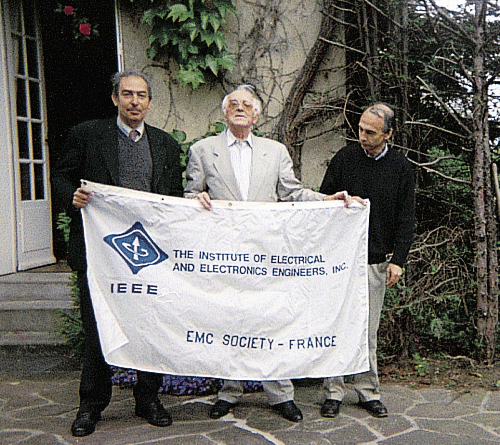 |
Ferdy Mayer (center) passes the torch
as chairman of the French |
On May 29, 2000, in a French IEEE EMC Chapter board meeting, Prof. Ferdy Mayer confirmed his resignation as Chair. Dr. André Berthon has been nominated as new Chair and Dr. Yannick Beniguel will be the new Vice-Chair. Dr. Berthon has been the Chair of the EMC "Club" of the French Society of Electrical and Electronic Engineers (SEE). He is well positioned to encourage the development of the French IEEE EMC Chapter and to promote local cooperation with the SEE.
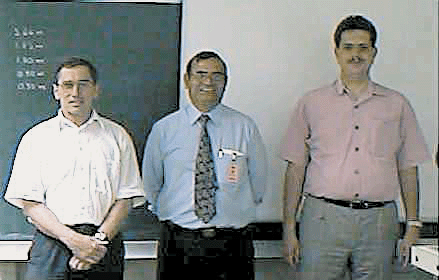 | 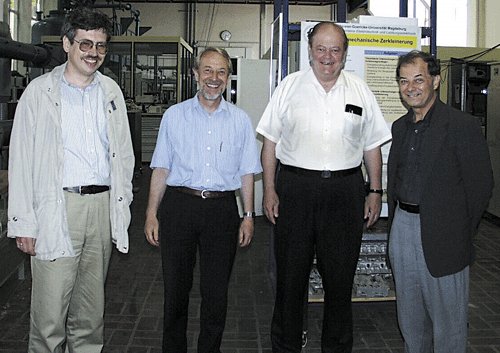 |
Dr. L. Schänzler head of the physics department, Dr. D. Giri distinguished speaker at the May meeting and Dr. F. Sabath. | Shown touring the EMC facilities at the University of Magdeburg are (L-R) Dr. Sergey Tkachenko, Dr. Juergen Nitsch, Dr. Carl E. Baum and Dr. Guenter Wollenberg. Note the big smiles! |
 | |
Speakers and organizers of the workshop on IRAs. Shown from the left are Dr. F. Sabath, Professor G. Mönich, Dr. C. E. Baum, Dr. B. Staginnus (head of the WIS) and D. Nitsch. |
Frank Gronwald reports that during the summer term the German EMC Chapter held a couple of meetings at the University of Magdeburg. Each presentation was attended by more than 20 members and guests.
The first meeting was held May 18th. The presenter was Dr. Ira Kohlberg from Kohlberg Associates, USA. Before he started to talk about the effects of unwanted electromagnetic signals on information networks, there was a certain time delay because some transparencies were missing. Due to the excellent driving skills of Dr. Juergen Nitsch, they were retrieved from a hotel room quite quickly while the waiting audience was entertained by a spontaneous presentation by Heiko Haase on his approach towards a full-wave transmission line theory. With a complete set of transparencies at hand, Ira Kohlberg followed up and shared his many interesting ideas on how the influence of EM fields on information networks can be described in a proper framework. It was a true pleasure to listen to his explanations and comments. Mathematics played also a major role in the May 23rd presentation of Dr. Wilhelm Ochs from the Fraunhofer Institute INT, Euskirchen on high-to-low frequency conversion in nonlinear circuits. For specific configurations, he obtained closed form results and therefore succeeded in illustrating the physical mechanisms behind these nonlinear processes.
Offspring of the German EMC Chapter took the lead on June 8th and 20th when Roland Tiedemann and Alexander Sturm, respectively, presented their research results. Both of them work at the University of Dresden and will finish their Ph.D. theses within the next few months. Roland Tiedemann gave a thorough overview of the measurement of transfer impedance and transfer admittance by his ingenious current line method. Alexander Sturm used differential geometry to obtain a new method for the treatment of diffraction in EMC-related problems.
Finally, on June 13th, Dr. Carl E. Baum from the Air Force Research Laboratory at Kirtland, USA, was present to share his unmatched experience on the electromagnetic interaction with and scattering from systems and targets of interest. Focus was put on electromagnetic topology and the singularity expansion method. All questions were answered in detail. It was very nice to have Carl. E. Baum not only as a speaker at the Chapter meeting, but he also stayed with the EMC group of the University of Magdeburg for a full week. This allowed for more detailed interaction, especially with another leading EMC expert, Dr. Sergey Tkachenko, who joined the Magdeburgian EMC group in April 2000. The German EMC Chapter is very glad to have Sergey Tkachenko in its surroundings!
Dr. Frank Sabath informed us of two additional meetings in Germany. The German EMC Chapter held two meetings on the topic of "Impulse Radiating Antennas". On May 16th Dr. Dave Giri contributed as a speaker to a technical meeting at the armed forces scientific institute for protection technologies (WIS) in Munster, Germany. Dr. Giri shared his practical expertise in electromagnetism and gave a lecture on "Impulse Radiating Antennas". After the presentation the participants were invited to visit the laboratory of the EMP protection department.
A two-day workshop on "Impulse Radiating Antennas" was held on June 19-20 in Munster, Germany. More than 30 participants joined the meeting and listened to seven presentations related to ultra wideband coupling to electronics and impulse radiating. The speakers, among them Dr. C. E. Baum, Professor J. Nitsch and Professor H. Garbe, lead a host of challenging discussions. The presentations were on a high scientific level and provided an enjoyable atmosphere for discussion.
The organization of the workshop had been put into the hands of Dr. F. Sabath and D. Nitsch who are with the EMP protection department of the armed forces scientific institute for protection technologies. Professor H. Garbe, Chairmen of the German EMC Chapter, thanks the armed forces scientific institute for protection technologies for the organization and the admirable support of the June meeting.
The Israel IEEE EMC Chapter held its second chapter meeting of the year and the millennium. Elya Joffe, Chair of the Israel Chapter, reports that the meeting took place as a full day workshop on April 18, 2000. The title of the Workshop was: "EU EMC Directive Revisited, and Israeli EMC Legislation." It was devoted primarily to a discussion of the recent updates in the EU EMC Directive, standards, and a discussion on the future of Israeli EMC legislation and standardization. The workshop took place at the Israeli Institution of Standards. Twenty-four participants and members took part in the workshop. Approximately half the participants were IEEE Members. The guest speaker for the workshop was Mr. Diethard Moehr from Siemens, who is deeply involved in EMC standardization and legislation as Secretary of IEC TC-77.
A welcome address was presented by Mrs. Ziva Patir, CEO of the Israeli Institution of Standards. Three presentations were given: "Development Trends in Israel's EMC Standardization and Legislation", presented by Elya B. Joffe, Chapter Chair, EMCS Distinguished Lecturer and Chairman of Israel's TC-809 (EMC Standards); "Updates on the EU EMC Standardization and Legislation: Part 1 Basics of the EEC EMC Directive and Standards", Mr. Diethard Moehr, Siemens, Secretary of IEC TC-77; "Updates on the EU EMC Standardization and Legislation: Part 2 New Trends in the EEC EMC Directive and Standards", also by Mr. Dietahrd Moehr. This Workshop was a special opportunity to discuss developments in Israeli EMC legislation, and for that purpose, a "Q&A Forum" was held. The forum was lead by Mr. Moehr, Mr. Joffe and a special guest participant, Mr. Grisha Deutch, Commissioner for Standardization in the Israel Department of Trade and Industry.
The entire event was a very useful one, with its special importance being the fact that Israeli EMC standardization, currently voluntary, and in the midst of the legislation process, making them mandatory, was, for the first time, discussed in an open forum of users, standard developers and the legislation authorities. We believe that this meeting has helped to accelerate the EMC legislation process in Israel.
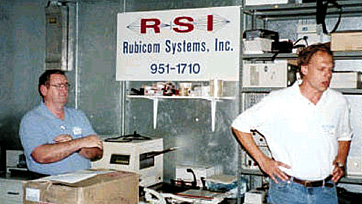 |
Chapter Chair Bruce Crain (right) introduces the Melbourne Chapter's guest speaker and meeting host, Mr. Joe Barbee of Rubicom Systems, Inc. |
The Melbourne, Florida EMC Chapter held its first meeting of the year on April 25. The meeting took place at Rubicom Systems, Inc., an EMC test laboratory located in Melbourne. A total of 15 engineers attended the meeting, where cold drinks and pizza were served.
The meeting's host and guest speaker was Mr. Joe Barbee, president of Rubicom Systems. Joe delivered a presentation titled "Developing an Independent EMC Laboratory", which chronicled his 13 years of experience as the founder, owner, and operator of an EMC test lab for MIL-STD-461/462, DO-160, FCC and CE mark. Joe's talk was entertaining and informative as he discussed the very creative and resourceful means that were required to start and establish his business. For instance, Joe described how he developed the lab's capability by acquiring test equipment through barter, trading test time for used equipment. He also carefully planned facility and equipment purchases, investing company profits in new capability over time. Even though Rubicom is now firmly established, this economically sound philosophy has continued, and the lab has a locally renowned reputation for keeping customer costs low by vigilantly controlling operating costs. Joe and his associate, Alex Belardinelli, also described how important it is to work with their customers to achieve successful product EMC compliance. For instance, they often provide EMC engineering expertise to customers who don't have EMC engineers on staff. They told several entertaining tales of how they were able to help frantic customers through the careful application of ferrite beads, filters, and EMI gaskets.
After Joe's presentation, the meeting attendees casually lingered to discuss EMC activities in the Melbourne area. Now in its second year, the Chapter has realized its goal of providing a friendly forum for the sharing of ideas and experience within the Melbourne EMC community.
At meetings on April 28th and 30th, Dr. Masayuki Fujise of the Communications Research Lab, Ministry of Post & Telecommunications - Japan, was the featured speaker. The title of his presentation was "Communications Technologies for Intelligent Transportation Systems." Part I was presented on the 28th and Part II was presented on the 30th. On May 18th, 33 people turned out to hear Xu-Chao Lan, of Xin-Lian Electronics Company, present a paper titled: "Application of Microwave Software to the CAD of Waveguide and Multi-Conductor Circuits."
A June 2nd meeting of the Nanjing chapter featured Prof. Ru-Shan Chen of the Nanjing Univ. of Science and Technology. His talk was titled, "Analysis of a Microwave Circulator Involving a Ferrite Ball." On June 15th, 58 people turned out to hear Professor Da-Gang Fang give a presentation titled, "Recent Progress of Numerical Techniques for Electromagnetics." Prof. Fang is also from the Nanjing Univ. of Science and Technology.
 |
Daryl Gerke of Kimmel-Gerke Associates (r) presents Bill Ritenour of EMC Compliance LLC with a jar of salsa as thanks for his talk of "PWB's - Where the Noise Starts." |
The Phoenix EMC Chapter held their last meeting of the season on May 18th, 2000. Bill Ritenour presented a well-received talk on printed wiring boards to about 30 attendees. His talk began "backwards" as he provided the various references for his talk including Henry Ott, Tom Van Doren, Bob Dockey, Clayton Paul, Todd Hubing, Howard Johnson and others. Bill reviewed the concept of PC board and cable resonance including the effects of ground plane inductance. The basis premise is that boards will resonate at frequencies associated with the board length equaling 1/2 wavelength or multiples thereof. Bill did an excellent job at recapping the concepts of common mode current generation and coupling. His notes are available for downloading at the Rocky Mountain EMC Chapter's web site.
The next meeting of the Phoenix chapter is planned for September 21, 2000 when Jack Opocensky of Polyphaser Inc. will be presenting a talk on lightning protection fundamentals. Check out our web site at https://www.ewh.ieee.org/r6/phoenix/phoenixemc / for the latest schedule on upcoming talks.
Lyle Luttrell, Chair of the Rocky Mountain EMC Chapter, reports that their April Meeting was held at the Holiday Inn, Northglenn, CO, and was hosted by Schaffner. Following a light buffet, Tony O'Hara, Lartec Marketing, did a great stand-in for Mr. Joseph Heins, Schaffner, in a presentation on "Radiated Emissions and Immunity Testing: TEM Cells to Anechoic Chambers."
The presentation detailed current commercial, telecom and automotive radiated emissions and immunity requirements. The TEM Cell, GTEM Cell and anechoic chamber measurement environments with test equipment characteristics were defined including benefits and shortcomings. Specific attention was offered for EUT and associated cable configuration, typical setups, industry standard practices and pre-compliance versus compliance. The presentation concluded with an overview of conducted susceptibility per EN6 1000-4-6. The conducted methodology was discussed for both compliance to the standard and pre-compliance for radiated fields up to 1GHz. The presentation is available for download at the RMC website. Prior to the technical presentation, Jim West, Chairman of the Denver IEEE Section, visited our meeting and provided a short summary of IEEE activities. He talked to the group about the Denver Section activities with respect to the email list, pre-college, senior membership, college speakers, etc.
Our 2000 Regional Symposium on EMC was a great success! The 10th Annual Symposium was held May 23 at the Holiday Inn Northglenn, which again provided a good location for our program. The Technical Program was a full day with ten excellent papers, including our first student paper, and six tutorials. Technical Exhibits by 26 regional and national firms provided attendees with the opportunity to learn more about the latest products and services for EMC design and testing. Participation by the Colorado Product Safety Technical Committee helped round out the program. Our attendance of 126 matched that of 1999. Attendees, presenters and exhibitors agreed that this was an exceptional program for EMC and Product Safety professionals. The symposium included a continental breakfast and free buffet lunch for all registrants, sponsored by Criterion Technology, Chomerics, and TUV Product Service. Fortunately, the afternoon speakers were able to keep everyone awake after that lunch!
The technical program is available at our web site, with many technical papers available for download. The site also includes links to exhibitors and sponsor web sites. The site address is https://www.ewh.ieee.org/r5/denver/rockymountainemc /. Thanks to everyone that made this symposium a great success! Special thanks to the symposium committee and helpers: Lyle Luttrell, Chas Grasso, Tony O'Hara, John Stadille, Bob Reinert, and Danny Odum.
The RMC June meeting was held at the StorageTek OATS, Louisville CO. A pizza supper was hosted by CASSPER Instrumentation Systems, and followed by a presentation and demonstration on "The CASSPER Ambient Cancellation Technology" by Dave Watkins, CASSPER Instrumentation Systems, Inc. CASSPER is a revolutionary new PC-based instrumentation system that records and isolates EUT signals of interest without the need for anechoic chambers. The system delivers true ambient cancellation and removes the guesswork in signal identification. The product's coherence measurement feature allows engineers to identify and locate sources of EMI noise, including multiple sources of the same frequency. This can save engineering time during the mitigation stage at the board, unit or system level. We were able to see a demonstration of the system to localize signals on a PWB. The demonstration was halted by an exciting Rocky Mountain thunderstorm!
In December 1999, members of the AP/MTT/EMC Society Chapter organized and hosted the Asia Pacific Microwave Conference in Singapore. The turnout was excellent with high-quality papers submitted. It was a huge success. In May, about 60 people turned out to hear Mark Montrose give a talk on "EMI and the PCB." Mr. Montrose is an IEEE EMC Society Distinguished Lecturer.
Alexander Worshevsky reports that the first meeting of the new joint EMC/PE/AES/C chapter took place in Saint Petersburg, Russia on May 18th featuring the Chapter's EMCS "Angel" and Distinguished Lecturer, Elya Joffe. Elya gave an excellent lecture to the IEEE members and guests. The event was arranged in Scientists' House - the former Palace of the Tsar's brother near the famous Hermitage Museum. Participants could see the river Neva and Peter and Paul Fortress from the windows. In the first part of the meeting, Elya described IEEE EMCS activities. He provided IEEE membership application forms to guests and invited them to become EMCS members. Then Elya started his very interesting lecture on "EMC Case Histories and EMC Design in Systems." The participants asked many questions about technical details as well as global questions about information pollution on TV, radio and the Internet. EMCS member Professor Kostenko spoke about the importance of electromagnetic and information compatibility for humanity and raised the topic of Information Ecology Science for the struggle against information pollution. Elya answered all questions. Participants thanked him for the very informative presentation. They invited Elya to the National EMC Conference (September 2000) and other EMC events in Saint Petersburg.
 | 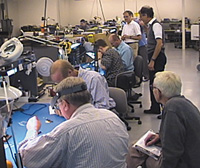 |
Seattle EMC Chapter Chairman Ghery Pettit (R) presents speaker Maqsood Mohd with a gift following his presentation at the April meeting. | Speaker Doug Smith (standing right) watches the teams assemble their probes at the May Seattle EMC Chapter meeting held at the Kalmus facility in Bothell. |
 | |
While team members anxiously watch, Doug Smith (kneeling) checks the performance of a probe. |
Janet O'Neil, Vice-Chair of the Seattle EMC Chapter, reports that the April and May Chapter meetings featured speakers from opposite ends of the country. In April, Maqsood Mohd came to Seattle from the Eglin AFB area in Florida. In May, Doug Smith visited the Chapter from his home base in Northern California.
On April 24, Dr. Maqsood A. Mohd spoke on the topic "Lightning Effects on Electronics and Humans." With the "Ph.D., NCE, Sverdrup Technology, Eglin AFB, Florida, Technical Fellow, EM Effects" following his name on the program, one knew an expert on the topic was present! The presentation began by describing lightning phenomenology and its direct and indirect effects. Several incredible photos of various lightning strikes were shown. The impact of direct and indirect effects on electronics systems and humans was discussed. Lastly, an indirect method to test for the lightning effects on an aircraft was discussed with an example. The presentation was an excellent and thorough overview of lightning to satisfy those new as well as familiar with the topic.
By popular demand, IEEE EMC Society Distinguished Lecturer Doug Smith returned to Seattle on May 16 to conduct his popular event "Build Your Own Probe." Doug conducted a special four-hour training where attendees learned to build their own probes on site under Mr. Smith's expert supervision. The training was held at the Kalmus facility in Bothell. Jeannie Olson and Leo Smale of Kalmus generously provided the workstations and tools. The chapter provided all the materials required to build the probes and dinner. The training was held from 4:00 pm to 8:00 pm, with a 45-minute dinner break. The evening began with a one-hour tutorial presentation on scope probes. This provided background information on signal integrity measurement using scope probes. Some of the pitfalls and limitations of probing were covered. Solutions to common measurement problems were provided. After the presentation and dinner break, materials were available for everyone to build their own 1 GHz passive 20X probe. Attendees broke into teams of two to build their probes. With a spectrum analyzer provided courtesy of the local Agilent Technologies representative and nearby CKC Labs, Doug evaluated the performance of the various probes. It was interesting to see how competitive the teams were during this evaluation process! It was a fun hands-on event for the chapter. Many thanks to Kalmus for providing their facility for the evening and for arranging the delicious, spicy (whew!) dinner.
Before breaking for the summer months, the Chapter elected new officers for 2000/2001. Newly elected were Janet O'Neil of ETS-Lindgren as Chairman and Pat Andre of CKC Labs as Vice-Chairman. Reelected were Stephen Stimac as Secretary and Kitty Tam of Northwest EMC as Treasurer. Outgoing Chairman Ghery Pettit of Intel was applauded for his leadership of the chapter for the past three years.
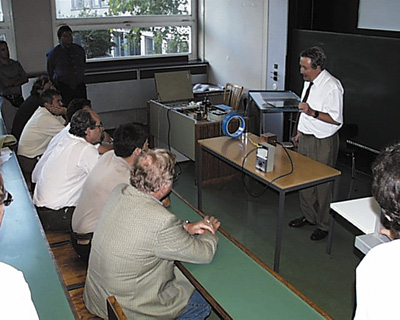 |
Professor Hadrian demonstrates the shielding effectiveness of materials to members of the Vienna Chapter. |
EMC